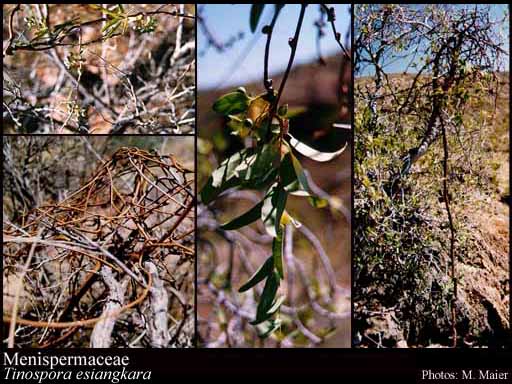- Reference
- Gen.Pl. [Jussieu] 284 (1789)
- Name Status
- Current

Scientific Description
Common name. Moonseed Family.
Habit and leaf form. Scandent shrubs, or lianas, or herbs (rarely), or trees (rarely). Climbing (usually), or self supporting; mostly stem twiners. Stephania twining clockwise. Mesophytic. Leaves alternate; spiral (usually with serial axillary buds); petiolate; non-sheathing; simple (usually), or compound (rarely); peltate (sometimes), or not peltate; when compound, ternate. Leaf blades when simple, entire (usually), or dissected; when simple/dissected, palmately lobed; pinnately veined, or palmately veined; cross-venulate. Leaves without stipules; without a persistent basal meristem. Domatia recorded (5 genera); represented by pits, or pockets, or hair tufts (rarely). Leaf anatomy. Hydathodes present (occasionally), or absent. Stem anatomy. Nodes tri-lacunar. Secondary thickening usually anomalous; mostly via concentric cambia.
Reproductive type, pollination. Fertile flowers functionally male, or functionally female, or functionally male and functionally female. Unisexual flowers present. Plants monoecious, or dioecious (mostly). Female flowers with staminodes, or without staminodes.
Inflorescence and flower features. Flowers solitary (rarely), or aggregated in ‘inflorescences’ (sometimes cauliflorous); in cymes, in panicles, and in fascicles. The terminal inflorescence unit cymose. Inflorescences axillary, or cauliflorous. Flowers small (rarely brightly coloured); regular (usually), or somewhat irregular; more or less 3 merous; cyclic; often approximating to K3+3, C3+3, A3+3, G3 — but with many exceptions. Floral receptacle developing a gynophore (sometimes), or with neither androphore nor gynophore. Free hypanthium absent. Perianth with distinct calyx and corolla (usually), or sepaline (occasionally without petals); (1–)6(–12), or (4–)12(–24); 2–6 -whorled; isomerous, or anisomerous. Calyx (1–)6(–12); often 2 -whorled; usually polysepalous; imbricate, or valvate. Corolla when present (i.e. usually), (3–)6(–12); often 2 -whorled; polypetalous (usually), or gamopetalous (rarely). Fertile stamens present, or absent (female flowers). Androecium (1–)6(–40). Androecial members branched, or unbranched; free of the perianth; free of one another, or coherent (the filaments often connate or in bundles); when joined 1 - adelphous, or 2–5 - adelphous; often 2 -whorled. Androecium exclusively of fertile stamens. Stamens (1–)6(–40); reduced in number relative to the adjacent perianth to isomerous with the perianth to polystemonous; often alternisepalous. Anthers dehiscing via longitudinal slits, or dehiscing transversely; introrse; tetrasporangiate. Fertile gynoecium present, or absent (male flowers). Gynoecium (1–)3 carpelled, or 6–30 carpelled (in one or more whorls); monomerous, or apocarpous; of one carpel, or eu-apocarpous; superior. Carpel apically stigmatic; 2 ovuled (one abortive). Placentation marginal (ventral). Stigmas dry type; non-papillate; Group II type. Ovules pendulous to horizontal; anatropous to amphitropous, or hemianatropous.
Fruit and seed features. Fruit fleshy to non-fleshy; an aggregate (in a head). The fruiting carpels not coalescing (each usually curved). The fruiting carpel indehiscent; nucular, or drupaceous (usually curved, often horseshoe shaped). Fruit 1 seeded. Seeds endospermic, or non-endospermic. Endosperm when present, ruminate, or not ruminate; oily. Cotyledons 2. Embryo straight to curved. Seedling. Germination phanerocotylar, or cryptocotylar.
Physiology, biochemistry. Aluminium accumulation not found. Photosynthetic pathway: C3.
Geography, cytology, number of species. World distribution: pantropical and warm. X = 11–13, 19, 25. 520 species.
Keys
Western Australian Genera and Families of Flowering Plants — an interactive key
T.D. Macfarlane, L. Watson, N.G. Marchant